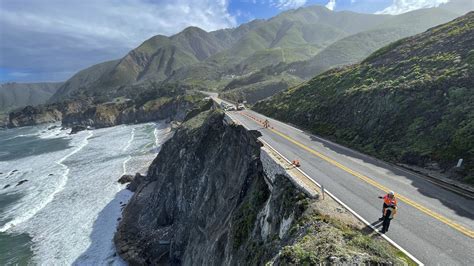The collapse of a segment of Highway 1 in Big Sur, California, has brought attention to the fragile nature of this scenic route and the challenges posed by the region’s geology and climate. On January 28, 2021, a significant portion of the highway was washed out due to heavy rainfall, prompting emergency repairs and raising questions about the long-term sustainability of this critical transportation artery.
To understand the factors contributing to the Big Sur road collapse, it’s essential to consider the unique combination of geographical and climatic conditions in the area. Big Sur is known for its rugged landscape, characterized by steep slopes, dense forests, and a coastline pounded by the Pacific Ocean. This environment is prone to landslides, rockfalls, and erosion, particularly during periods of intense rainfall.
One of the primary causes of the collapse was the extraordinary precipitation that hit the region in late January 2021. A powerful storm system brought heavy rain to Central California, with some areas receiving over 10 inches of precipitation in a short period. This deluge overwhelmed the local drainage systems, causing widespread flooding and triggering landslides in vulnerable areas.
The specific segment of Highway 1 that failed was located near the community of Rat Creek, approximately 15 miles south of Big Sur Village. The area is notorious for its instability, with a history of landslides and road closures. In the days leading up to the collapse, the California Department of Transportation (Caltrans) had been monitoring the situation closely, aware of the increasing risks posed by the heavy rainfall.
When the road gave way, it was not entirely unexpected. However, the scale of the damage was unprecedented, with a massive chunk of the highway disappearing into the ocean. The collapse left a significant gap in the road, rendering it impassable and disrupting the flow of traffic between the Central Coast and the Monterey Bay area.
In the aftermath of the collapse, Caltrans embarked on an ambitious repair project to restore the highway to its original state. The agency faced significant challenges, including the need to stabilize the surrounding terrain, rebuild the damaged section of road, and ensure the long-term viability of the repair.
To address these challenges, Caltrans adopted a multi-faceted approach. First, the agency conducted a thorough assessment of the site to determine the extent of the damage and identify potential causes of the collapse. This involved geotechnical analysis, drainage assessment, and evaluation of the existing infrastructure.
Next, Caltrans developed a comprehensive repair plan, which included the following key components:
- Site stabilization: Caltrans implemented measures to stabilize the surrounding terrain, including the installation of rock nets, debris fences, and other erosion control systems.
- Road reconstruction: The agency rebuilt the damaged section of Highway 1, using a combination of conventional construction techniques and innovative materials to ensure the new roadbed was stable and durable.
- Drainage improvements: Caltrans upgraded the local drainage system to prevent similar flooding events in the future, including the installation of new culverts and the enhancement of existing drainage infrastructure.
- Geotechnical monitoring: The agency implemented a monitoring program to track the stability of the surrounding terrain and detect early warning signs of potential landslides or other hazards.
As of the latest updates, the repair project is progressing steadily, with Caltrans working to complete the reconstruction of the damaged highway segment. While the agency has not provided a definitive timeline for the completion of the project, it is expected that the road will be fully restored to its original state within the next few months.
The Big Sur road collapse serves as a stark reminder of the importance of investing in infrastructure resilience and the need for proactive maintenance and repair strategies. As the region continues to experience extreme weather events, it is crucial that transportation agencies and stakeholders prioritize the development of adaptable and sustainable infrastructure solutions that can withstand the challenges posed by a changing climate.
In conclusion, the collapse of Highway 1 in Big Sur was a complex event driven by a combination of geological and climatic factors. While the repair project is ongoing, it is clear that the restoration of the highway will require a sustained effort to stabilize the surrounding terrain, rebuild the damaged road, and ensure the long-term viability of the repair. As the region looks to the future, it is essential that stakeholders prioritize infrastructure resilience and develop proactive strategies to mitigate the risks associated with extreme weather events.
What caused the Big Sur road collapse?
+The Big Sur road collapse was caused by a combination of heavy rainfall, geological instability, and the resulting flooding and landslides. The area is prone to such events due to its rugged terrain and proximity to the Pacific Ocean.
How long will the repair project take?
+The duration of the repair project is currently uncertain, but Caltrans is working to complete the reconstruction of the damaged highway segment as soon as possible. The agency will provide updates on the project timeline as more information becomes available.
What measures are being taken to prevent similar events in the future?
+Caltrans is implementing various measures to prevent similar events, including site stabilization, drainage improvements, and geotechnical monitoring. The agency is also exploring innovative solutions and materials to enhance the resilience of the highway infrastructure.
In the context of the Big Sur road collapse, it is essential to recognize the interconnectedness of infrastructure, geology, and climate. As the region moves forward, it is crucial that stakeholders prioritize proactive strategies to mitigate the risks associated with extreme weather events and invest in infrastructure resilience to ensure the long-term sustainability of critical transportation arteries like Highway 1.



